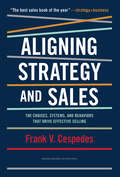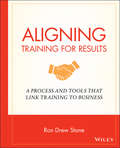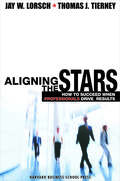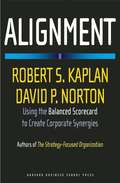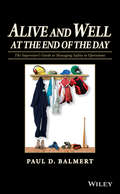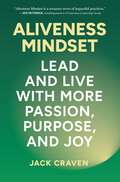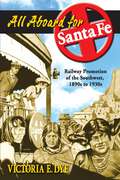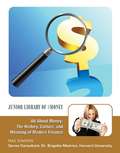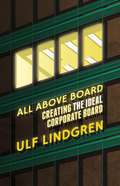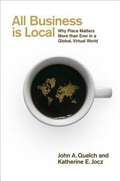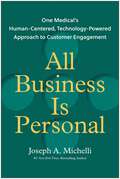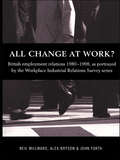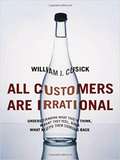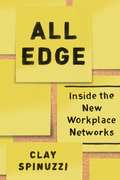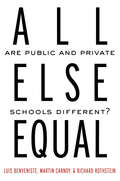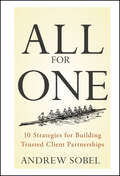- Table View
- List View
Aligning Strategy and Sales: The Choices, System, and Behaviors That Drive Effective Selling
by Frank V. CespedesIt's time to address the enormous cost of the strategy-sales gap. The most crucial connection in an organization seeking to grow is between sales and strategy. But if your company is like most, instead of a strong connection there is a widening gap and too little bang for the buck. This book will help turn the tide for your organization. US companies, for example, invest almost $900 billion annually in their sales forces-more than three times the amount they spend on all media advertising, and twenty times more than the total spent on digital marketing. Yet research indicates that, on average, companies deliver only about 50 to 60 percent of the financial performance their strategies promise. That's a lot of wasted money and managerial effort. Aligning Strategy and Sales will help you close the gap, establish the needed connections, and improve both sales and strategy in your organization. From the author's research, practice, and years of work with firms across many industries, you'll learn how to improve performance by: - Articulating strategy in ways that busy people can understand and embrace, and then translating strategic choices into sales tasks that bring results. - Hiring, compensating, and measuring salespeople and performance in ways that are consistent with strategic goals. - Selecting and developing people who can manage as well as sell, and finding practical ways to improve the coordination between sales and other functions required for profitable growth. Usable, thoughtful, and clear, this book will help you drive performance, evaluate sales numbers, and hire or train the people who deal with your customers-from sales and functional heads to HR and the C-suite. Informed by the author's experience and research as a business manager, board member, consultant, and professor at Harvard Business School, Aligning Strategy and Sales provides the know-how and tools to do exactly what its title promises.
Aligning Strategy and Sales: The Choices, System, and Behaviors That Drive Effective Selling
by Frank V. Cespedes"The best sales book of the year" - strategy+business magazine That gap between your company’s sales efforts and strategy? It’s real-and a huge vulnerability. Addressing that gap, actionably and with attention to relevant research, is the focus of this book. In Aligning Strategy and Sales, Harvard Business School professor Frank Cespedes equips you to link your go-to-market initiatives with strategic goals. Cespedes offers a road map to articulate strategy in ways that people in the field can understand and that will fuel the behaviors required for profitable growth. Without that alignment, leaders will press for better execution when they need a better strategy, or change strategic direction with great cost and turmoil when they should focus on the basics of sales execution. With thoughtful, clear, and engaging examples, Aligning Strategy and Sales provides a framework for diagnosing and managing the core levers available for effective selling in any organization. It will give you the know-how and tools to move from ideas to action and build a sales effort linked to your firm’s unique goals, not a generic selling formula. Cespedes shows how sales efforts affect all elements of value creation in a business, whether you’re a start-up seeking to scale or an established firm looking to jump-start new growth. The book provides key insights to optimize your firm’s customer management activities and so improve selling and strategy.
Aligning Support Functions
by Robert S. Kaplan David P. NortonOrganizations create shareholder value by aligning their business units with corporate strategy. But organizations also create value by aligning their support units with business unit strategy. This chapter looks at how support units contribute to organizational synergies when they align their activities with business unit and enterprise priorities.
Aligning Training for Results
by Ron Drew StoneWhat makes some training programs successful while others produce disappointing results? The answer, says Ron Stone, lies in the processes trainers employ to determine needs, design and develop programs, deliver the training, and partner to get business results. It is time to reexamine these processes, says the author, and bring them into the twenty-first century. In Aligning Training for Results Stone provides a potent, comprehensive, and versatile resource to help guide trainers through assessing, designing, and delivering training solutions that achieve real and measurable results.Note: CD-ROM/DVD and other supplementary materials are not included as part of eBook file.
Aligning Your Star: Build a Life, Not a Resume
by Jay W. Lorsch Thomas J. TierneyBecause professional service firms depend on outstanding professionals, the personal needs, motivation, and careers of individuals are of the utmost importance. This chapter turns the spotlight on the reader, looking at why--and how--the concept of alignment can be as powerful on a personal level as it is when applied to the direction of the firm overall.
Aligning the Energy Transition with the Sustainable Development Goals: Key Insights from Energy System Modelling (Lecture Notes in Energy #101)
by George Giannakidis Maryse Labriet Brian Ó Gallachóir Kari EspegrenThis open access book brings together concrete analyses from around the world, spanning various scales, that shed light on strategies for implementing essential energy and climate transitions within the broader context of UN Sustainable Development Goal (SDG) imperatives. Specifically, the book exemplifies the advancement, adaptation, and utilization of energy systems models to address intricate policy issues around pathways to achieve net-zero emissions, enhance energy security, optimize investments, and understand their societal implications. It explores the intricate connections between the SDGs concerning energy, climate action, and other developmental priorities such as employment and economic growth, industrial innovation, urban development, responsible consumption and production, and collaborative partnerships. Organized into four sections, the book illustrates the necessary adjustments of energy system models to guide SDGs, evaluates the role of modeling to advance both renewable energy and energy security, and showcases how energy systems are harnessed to engage with international, national, and local policymakers. This book is available open access under a Creative Commons Attribution 4.0 International License via link.springer.com.
Aligning the Organization for Growth: A Discovery-Driven Approach
by Ian C. Macmillan Rita Gunther McgrathA lot of good companies waste enormous amounts of resources on too many projects that have too little focus. Once you have taken the first steps in the planning process and created a framework for growth, the next step is to analyze how resources are currently being allocated to growth initiatives and consider how these allocations need to change based on the new framework. This chapter reviews how you can make sure that your resources and other organizational capabilities are aligned with the strategy that your senior team has established. This chapter is excerpted from "Discovery-Driven Growth: A Breakthrough Process to Reduce Risk and Seize Opportunity."
Aligning the Stars
by Jay W. Lorsch Thomas J. TierneyMost businesses rely on talent to succeed, but none so much as professional service firms. Within this rapidly expanding, trillion-dollar industry, professionals--and how they're managed--are the primary source of competitive advantage. In fact, success in this sector is determined more by the people you pay than the people who pay you. This path-breaking book provides readers with a practical and integrated perspective on how to win in the unique and tumultuous world of professional services. From strategy to organization to culture, it offers customized insights for businesses in which professionals drive bottom-line results and long-term company success. Respected academic Jay W. Lorsch and accomplished practitioner Thomas J. Tierney apply their broad experience to the realities of "Monday morning" decision making. Their work reflects decades of personal experience, combined with a rigorous study of outstanding professional service firms in industries that include law, information technology, accounting, advertising, investment banking, executive search, and consulting. Aligning the Stars explains what differentiates the "best of the best" within professional services. By describing how to attract, retain, motivate, organize, and lead the stars that shape a company's destiny, this book provides valuable lessons for the current and future leaders of every talent-driven business.
Aligning: Fundamental to Achieving Payback
by John Butman Harold L. Sirkin James P. AndrewThis chapter focuses on the importance of aligning the various organizational units, disciplines, activities, structures, and processes around driving innovation and creating payback.
Alignment
by Robert S. Kaplan David P. NortonMost organizations consist of multiple business and support units, each populated by highly trained, experienced executives. But often the efforts of individual units are not coordinated, resulting in conflicts, lost opportunities, and diminished performance.Robert S. Kaplan and David P. Norton argue that the responsibility for this critical alignment lies with corporate headquarters. In this book, the authors apply their revolutionary Balanced Scorecard management system to corporate-level strategy, revealing how highly successful enterprises achieve powerful synergies by explicitly defining corporate headquarters' role in setting, coordinating, and overseeing organizational strategy.Based on extensive field research in organizations worldwide, Alignment shows how companies can build an enterprise-level Strategy Map and Balanced Scorecard that clearly articulate the "enterprise value proposition": how the enterprise creates value above that achieved by individual business units operating alone. The book provides case studies, actionable frameworks, and sample scorecards that show how to align business and support units, boards of directors, and external partners with the corporate strategy and create a governance process that will ensure that alignment is sustained.The next breakthrough in strategy execution from the field's premier thinkers, Alignment shows how today's companies can unlock unrealized value from enterprise synergies.
Alignment: A Provider's Guide to Managing the Practice of Health Care (Haworth Marketing Resources Ser.)
by William Winston Paul A SommersAlignment: A Provider’s Guide to Managing the Practice of Health Care uses the method of alignment with proven examples and strategies to help health care providers achieve and maintain optimum effectiveness through continuous enhancement. Focusing on defining information and using it to distinguish your company or practice from the competition, this book is designed to help you take a proactive and cooperative role in health care to benefit patients or your business. From Alignment: A Provider’s Guide to Managing the Practice of Health Care, you’ll receive proven solutions to current problems in order to deliver the best possible services to clients and patients.This book defines alignment as the shortest distance from initiation to successful completion of any desired activity. With this goal in mind, Alignment offers you dozens of recommendations, proven strategies, and examples that will improve your services, including: designing health care systems to meet patient needs and accreditations by stressing clear communication and keeping up with current medical technology developing a checklist that includes four-year goals, defining your capabilities, analyzing finances for cost-effectiveness, and deciding important features to attract new patients and satisfy customers improving service quality by evaluating satisfaction surveys and developing short-term and long-term health care packages that meet employees’individual needs ensuring customer satisfaction by asking patients about their expectations and their needs educating physicians on customer-oriented service and rewarding them for competence and caring reducing the time between the initial patient visit and when the final bill is paid to enhance revenue flow Alignment is complete with graphs, tables, recommendations, objectives and solutions, examples, and a glossary to give you a thorough understanding of current concepts and ideas. Within Alignment: A Provider’s Guide to Managing the Practice of Health Care, you’ll discover innovative and proven techniques that will improve physician/administrator and physician/patient relationships to make your business effective and successful for you and your clients.
Alignment: A Source of Economic Value
by Robert S. Kaplan David P. NortonCorporations must continually search for ways to make the whole more valuable than the sum of its parts. Alignment is critical if enterprises are to achieve synergies throughout their business and support units. This chapter illustrates that enterprises enjoying the greatest benefits from their performance management systems (based on Strategy Maps and Balanced Scorecards) are much better at aligning their corporate, business unit, and support unit strategies, indicating that alignment, much like the synchronism achieved by a high-performance rowing crew, produces dramatic benefits.
Alive and Well at the End of the Day
by Paul D. BalmertProven strategies and tactics that you can use to lead workers to safetyIndustrial facilities supervisors, from front-line managers to CEOs, can depend on Alive and Well at the End of the Day for tested and proven management and leadership practices that ensure the safety of their workers. With more than thirty years of hands-on experience in the chemical industry, including front-line management, author Paul Balmert understands the challenges facing supervisors in industrial facilities. His advice, based on firsthand experience, shows you how to identify and correct flaws in industrial practices. Moreover, he shows you how to lead by example, overcoming all obstacles that interfere with safety.Rather than focus on theory, this book offers concrete strategies and tactics that enable you to:Recognize and capitalize on the moments when workers are most receptive to learning safetyDiscover what's really going on when you tour and inspect plant operationsEngage in a helpful discussion with someone who is not following safety guidelinesUnderstand the various types of risk involved in an industrial operationImplement a comprehensive strategy to manage and minimize riskThroughout the book, plenty of case studies and examples illustrate key challenges alongside step-by-step solutions. You'll also learn how to understand and leverage the psychology and motivations of your staff in order to fully implement safety practices and procedures. In short, with this book as your guide, you will be equipped and ready to lead your staff to safety.
Aliveness Mindset: Lead and Live with More Passion, Purpose, and Joy
by Jack CravenJack Craven&’s Aliveness Mindset is an invitation for anyone feeling stuck to awaken to a life of renewed passion, greater purpose, and authentic joy.When did you last feel truly alive? What if you could experience that feeling not just once in a while but every single day? That is the promise and goal of an Aliveness Mindset. You are fully capable of bringing the best, most vibrantly alive version of yourself into the world day after day. Aliveness is already within you, but you have to define it and find it, guard it and grow it. It must be discovered because you are unique and so is your experience of aliveness. In Aliveness Mindset, executive coach Jack Craven shares the principles and strategies he has used to lead countless CEOs and high-level business leaders into a more fulfilling, authentic life. His practices are not a series of impersonal steps or a formula to blindly follow but rather an organic process of self-understanding and personal growth. In Aliveness Mindset, you will: 1. Create your own Aliveness Mindset. 2. Learn the simple yet powerful components of the Circle of Aliveness. 3. Discover the unique way you experience aliveness and how to remain in this &“Optimal State&” despite the ups and downs of life. 4. Understand the seven components of an Aliveness Mindset and how they work together to power your aliveness journey. 5. Receive practical, proven strategies to restore and expand your experience of aliveness.
All Aboard for Santa Fe: Railway Promotion of the Southwest, 1890s to 1930s
by Victoria E. DyeBy the late 1800s, the major mode of transportation for travelers to the Southwest was by rail. In 1878, the Atchison, Topeka, and Santa Fe Railway Company (AT&SF) became the first railroad to enter New Mexico, and by the late 1890s it controlled more than half of the track-miles in the Territory. The company wielded tremendous power in New Mexico, and soon made tourism an important facet of its financial enterprise.All Aboard for Santa Fe focuses on the AT&SF's marketing efforts to highlight Santa Fe as an ideal tourism destination. The company marketed the healthful benefits of the area's dry desert air, a strong selling point for eastern city-dwelling tuberculosis sufferers. AT&SF also joined forces with the Fred Harvey Company, owner of numerous hotels and restaurants along the rail line, to promote Santa Fe. Together, they developed materials emphasizing Santa Fe's Indian and Hispanic cultures, promoting artists from the area's art colonies, and created the Indian Detours sightseeing tours. All Aboard for Santa Fe is a comprehensive study of AT&SF's early involvement in the establishment of western tourism and the mystique of Santa Fe.
All About Money (Rookie Read-about Math Ser.)
by Erin Roberson<br>- Simplifies complex math concepts <br>- Explains concepts using real-life situations and familiar objects <br>- Clear linkage between text and photos <br>- Words You Know section to reinforce text <br>- Index <br>Grades K-4 National Social Studies Standards <br>- Production, Distribution, and Consumption: VII <br>- Explain the role of money in everyday life <br>- Describe influence on economic decisions <br>- Time, Continuity, and Change: II <br>- Identify examples of change
All About Money: The History, Culture, and Meaning of Modern Finance
by Rae SimonsGetting a job can be a great way to earn some money, gain valuable work experience, and get a sense of what you want to do in your future career. Learn all this and more in Earning Money: Jobs.
All Above Board
by Ulf LindgrenBased on unique access interviews with leading chairmen and senior executives, All Above Board examines the key functions of the ideal 21st century board, how and why badly led boards fail, and what changes can be made to improve board behavior and efficiency for best practice.
All Business Is Local
by John A. Quelch Katherine E. JoczWhy businesses should never underestimate the power of place. Today's business leaders are so obsessed with all things global and virtual that they risk neglecting the critical impact of physical place. It's a paradox of the Internet age: now that it's possible for businesses to be everywhere at once, they need to focus on what it means to be one specific place at a time. The best global brands, from IBM to McDonald's, are by design also the leading local brands. For instance, your decision to patronize Starbucks will depend on whether it's the best local coffee shop in your neighborhood, not on how many thousands of global locations it has. Marketing experts John Quelch and Katherine Jocz offer a new way to think about place in every strategic decision-from how to leverage consumer associations with locations to where to position products on the shelf. They explore case studies such as Nike and The Apple Store, which use place in creative ways. Drawing on a blend of hard data and engaging anecdotes, this book will help any business-from global mega-brands to boutique, small town stores- influence customers more effectively. .
All Business Is Personal: One Medical's Human-Centered, Technology-Powered Approach to Customer Engagement
by Joseph A. MichelliFrom organizational consultant and bestselling author Joseph Michelli, a close look at the groundbreaking practices at Amazon&’s One Medical, revealing the key strategies that make them a revolutionary force in healthcare and an inspiration for all industries.What if every business owner or manager could combine cutting-edge technology with the warmth of personal connection to keep customers coming back for more and sending their friends and family? Drawing lessons from the industry-leading business practices at One Medical, a brand transforming the customer experience in healthcare, All Business Is Personal gives readers tools to blend the powerful benefits of today&’s rapidly improving technology with individuals&’ unique talents, all in the name of providing only the best for their customers. Readers will learn: How to increase the value provided to colleagues, customers, and business partners Examples of how to make the customer experience easier, more accessible, and more successful An iterative process for thoughtfully designing the customer experience The importance of growing your people first before growing your business to develop a sustainable and high-performing organization All Business Is Personal is your roadmap for blending people and technology to elevate the employee and customer experiences, drive repeat business, garner word-of-mouth referrals, and ensure sustainable organic growth.
All Change at Work?: British Employment Relations 1980-98, Portrayed by the Workplace Industrial Relations Survey Series
by Alex Bryson John Forth Neil MillwardThis book is the latest publication reporting the results of a series of workplace surveys conducted by the Department of Trade and Industry, the Economic and Social Research Council, the Advisory Conciliation and Arbitration Service and the Policy Studies Institute. It addresses such contemporary employee relations issues as: * Have new configurations of labour-management practices become embedded in the British economy? * Did the dramatic decline in trade union representation in the 1980s continue throughout the 1990s, leaving more employees without a voice? * Are the vestiges of union organisation at the workplace a hollow shell? The focus of this book is on change, captured by gathering together the enormous bank of data from all four of the large-scale and highly respected surveys, and plotting trends from 1980 to the present. In addition, a special panel of workplaces, surveyed in both 1990 and 1998, reveals the complex processes of change. Comprehensive in scope, the results are statistically reliable and reveal the nature and extent of change in all bar the smallest British workplaces. A key text for anyone interested in employment and the changing world of work, whether as student, researcher, teacher, analyst, adviser or practitioner.
All Customers Are Irrational: Understanding What They Think, What They Feel, and What Keeps Them Coming Back
by William J. CUSICKAs many businesses are discovering, customer behavior doesn’t always make sense. That really shouldn’t be surprising. As recent studies have shown, people tend to base their decisions on more subconscious, emotional desires than on rational, practical choices. What’s more, customers aren’t able to tell you accurately why they do what they do. Combining recent research findings with real-world examples from his consulting practice on customer experience, William J. Cusick examines how the subconscious part of the brain drives the decisions and behavior of every customer on a daily basis and introduces the concept of "the irrational customer." All Customers Are Irrational shows why businesses must change their approach to attracting and retaining customers, and proposes ways they can alter their strategies on everything from customer research, product design and website development to call center management, employee recruitment, and retail store layouts, by focusing on what customers are actually doing instead of what they’re saying. Honest, direct and insightful, All Customers Are Irrational will help businesses tap into the impulses and motivations that both attract and retain consumers for the long haul.
All Edge: Inside the New Workplace Networks
by Clay SpinuzziWork is changing. Speed and flexibility are more in demand than ever before thanks to an accelerating knowledge economy and sophisticated communication networks. These changes have forced a mass rethinking of the way we coordinate, collaborate, and communicate. Instead of projects coming to established teams, teams are increasingly converging around projects. These "all-edge adhocracies” are highly collaborative and mostly temporary, their edge coming from the ability to form links both inside and outside an organization. These nimble groups come together around a specific task, recruiting personnel, assigning roles, and establishing objectives. When the work is done they disband their members and take their skills to the next project. Spinuzzi offers for the first time a comprehensive framework for understanding how these new groups function and thrive. His rigorous analysis tackles both the pros and cons of this evolving workflow and is based in case studies of real all-edge adhocracies at work. His provocative results will challenge our long-held assumptions about how we should be doing work.
All Else Equal: Are Public and Private Schools Different?
by Martin Carnoy Richard Rothstein Luis BenvenistePrivate schools always provide a better education than public schools. Or do they? Inner-city private schools, most of which are Catholic, suffer from the same problems neighboring public schools have including large class sizes, unqualified teachers, outdated curricula, lack of parental involvement and stressful family and community circumstances. Straightforward and authoritative, All Else Equal challenges us to reconsider vital policy decisions and rethink the issues facing our current educational system.
All For One
by Andrew SobelCorporate clients are demanding more value from their external advisors, and consolidating their business around a smaller number of firms. These trends are forcing a variety of service providers--from consulting firms to large banks--to confront a series of difficult challenges: How do we create an 'all-for-one, one-for-all' culture in which the whole is greater than the sum-of-the-parts and we succeed in leveraging our global network to deliver value to clients?" How do we mobilize the right people, resources, and ideas--across a multitude of organizational and geographic boundaries--into each and every client relationship?" How do we evolve from a trusted advisor to a trusted partner and build multi-year, institutional relationships? All for One answers these questions with an innovative and comprehensive model for developing enduring, institutional client relationships--what Andrew Sobel refers to as Level 6 Trusted Client Partnerships. It offers readers ten specific strategies that are thoroughly supported by case studies, best practices from leading firms, and implementation tools. The individual professional is principally responsible for five of these strategies, while the firm--the institution--must support and drive the other five. When you successfully execute against all ten of these building blocks, you develop long-term, professional-client partnerships that provide great value to the client and high levels of personal satisfaction and profitability for the service provider.
